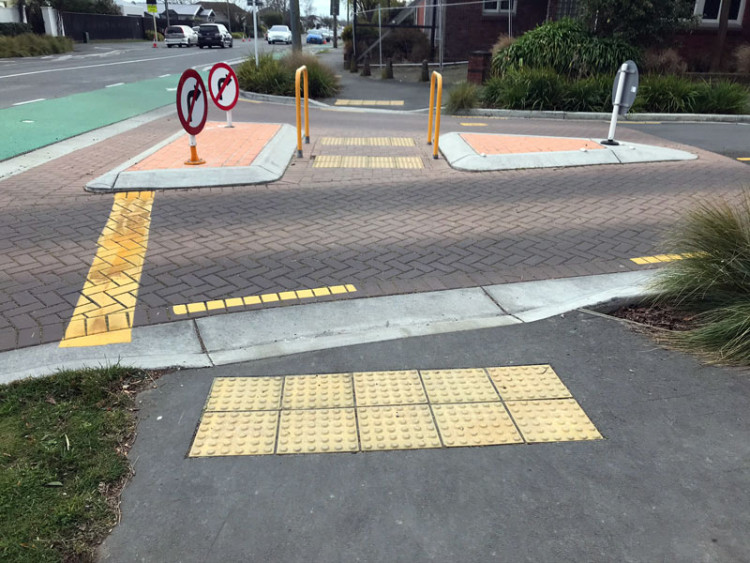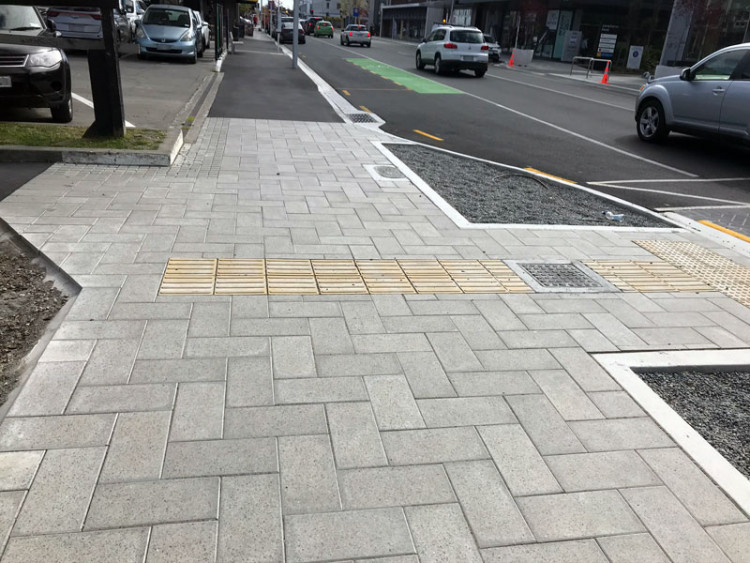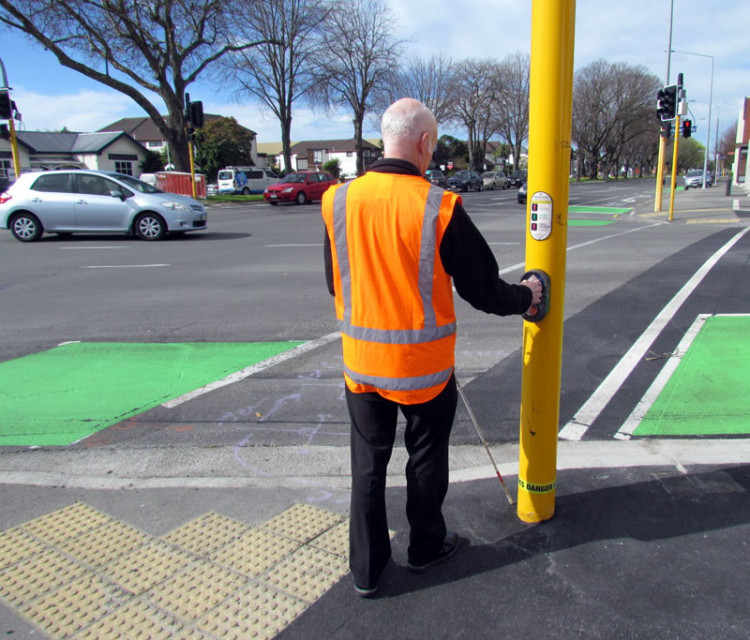Road and Traffic Standard 14 (RTS14) Guidelines for facilities for blind and vision impaired pedestrians specifies the design, installation and performance standards of pedestrian facilities especially for people who are blind or have low vision both for new facilities and for those that need to be upgraded.
A Waka Kotahi technical note and webinar provides designers and contractors with guidance on where and how tactile indicators should be installed including typical layouts and installation examples.
RTS14 - Guidelines for facilities for blind and vision impaired pedestrians [PDF, 1.6 MB]
PNG: Tactile indicator installation note and webinar
There are two features that are installed to assist people who are blind or have low vision on their walking journeys, tactile ground surface indicators (TGSI) and audible tactile traffic signals (ATTS) as outlined below.
Tactile ground surface indicators (TGSI) and also referred to as tactile indicators provide pedestrians with visual and sensory information. The two types of TGSI are warning indicators and directional indicators. Warning indicators alert pedestrians to hazards in the continuous accessible path of travel, indicating that they should stop to determine the nature of the hazard before proceeding further. They do not indicate what the hazard will be. The following photo shows a typical arrangement of warning indicators.

Warning tactile indicators (Tracy Fleming)
Directional indicators give directional orientation to people who are blind or have low vision when other tactile or environmental cues such as the property line or kerb edge are either absent or give insufficient guidance. Directional indicators should only be installed where a person must deviate from the continuous accessible path of travel to access a road crossing point, public transport access point or significant public facility. The following photo shows a typical arrangement of directional indicators.

Directional tactile indicators (Ann-Marie Head)
When combined with other environmental information, TGSI assist people who are blind or have low vision with their orientation and awareness of impending obstacles, hazards and changes in the direction of the continuous accessible path of travel.
Tactile indicators are generally safety yellow which provides visual contrast with the adjacent path surfacing. Other colours may be acceptable provided the visual contrast is sufficient. Only install green warning tactile indicators on a designated cycle crossing.
All new pedestrian facilities shall be designed and installed with features detailed in RTS14 and throughout the Pedestrian Network Guidance.
Warning indicators shall be installed to inform people who are blind or have low vision of:
Warning indicators may also be installed to inform people who are blind or have low vision of:
Directional indicators shall be used to provide directional guidance where a person must deviate from the continuous accessible path of travel to gain access to:
Where other environmental cues are insufficient, directional indicators may also be used to provide directional guidance:
It is better to remove obstacles from the continuous accessible path of travel than to install directional indicators.
Where an informal midblock crossing (eg pedestrian refuge) is located close to a priority crossing (eg traffic signals), it may be safer for a person who is blind or has low vision to cross at the formal crossing point. A decision to omit directional TGSI in this instance should only be made after consulting with Blind Low Vision NZ.
A Waka Kotahi technical note and webinar provides designers and contractors with guidance on where and how tactile indicators should be installed including typical layouts and installation examples. Further guidance is also provided in RTS14.
PNG: Tactile indicator installation note and webinar
Existing facilities should be prioritised for upgrades focussing on areas of high pedestrian activity first. The risk of a person who is blind or has low vision being injured in the absence of TGSI should be evaluated when prioritising the installation of TGSI. RTS14 (Section 2) provides further guidance on prioritising installation of TGSI. Prioritising TGSI installation should involve consultation with an orientation and mobility instructor at Blind Low Vision NZ.
Blind Low Vision NZ(external link)
Audible tactile traffic signals (ATTS) provide pedestrians with audible and tactile information at traffic signals. The audible features of ATTS help people who are blind or have low vision locate the pedestrian push button and inform them when to cross. The tactile features of ATTS also help those who are blind or have low vision with their orientation. ATTS also has benefits for fully sighted pedestrians.

Use of an audible push button at traffic signals. Note: The tactile indicators are not ideally located in relation to the ATTS in this situation (Ben Jassin)
ATTS shall be installed at all new and upgraded signalised intersections that include pedestrian signals. RTS14 (Section 6.4) outlines the key orientation and location principles for installing pedestrian push buttons at signalised intersections including placement in relation to TGSIs and kerb ramps.
RTS14 - Guidelines for facilities for blind and vision impaired pedestrians [PDF, 1.6 MB]
RTS14 (Section 2) provides further guidance on prioritising the upgrade of pedestrian signals to compliant ATTS systems. Prioritising ATTS at signalised intersections should involve consultation with an orientation and mobility instructor at Blind Low Vision NZ.